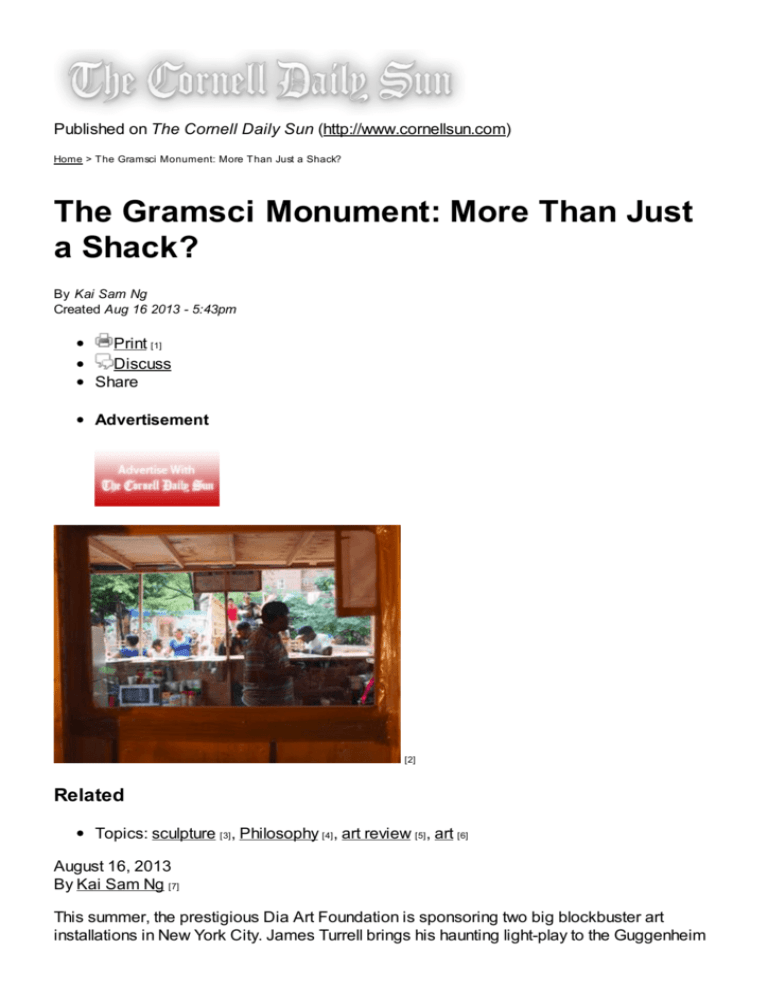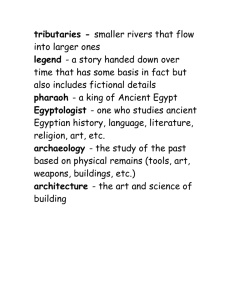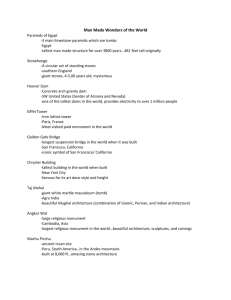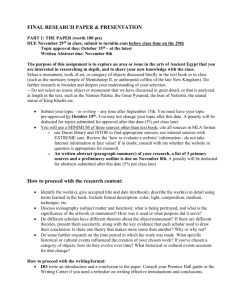
Published on The Cornell Daily Sun (http://www.cornellsun.com)
Home > The Gramsci Monument: More Than Just a Shack?
The Gramsci Monument: More Than Just
a Shack?
By Kai Sam Ng
Created Aug 16 2013 - 5:43pm
Print [1]
Discuss
Share
Advertisement
[2]
Related
Topics: sculpture [3] , Philosophy [4] , art review [5] , art [6]
August 16, 2013
By Kai Sam Ng [7]
This summer, the prestigious Dia Art Foundation is sponsoring two big blockbuster art
installations in New York City. James Turrell brings his haunting light-play to the Guggenheim
with Aten Reign, which unfortunately keeps selling out. The other is Thomas Hirschhorn's
Gramsci Monument, which is open without admission, lines or fees: the only barrier to entry is
a spontaneous subway trip to the Bronx.
It is strangely unsurprising that Hirschorn would devote an entire monument to the Marxist
philosopher Antonio Gramsci. Known for his high-concept works that tackle issues like
poverty, commercialism, and disposability, his meticulously assembled trash heaps often
don't evoke this claim to opposition politics—rather, he tells the press that they are
oppositional. Nevertheless, these pieces command a cult-like respect in the art world. The
monument is not the first Hirshhorn has devoted to a philosopher: it is actually his fourth and
final tribute to his favorite thinkers. All have been built by poor or working class people inside
housing projects they live in. And all three previous monuments— to Spinoza, Gilles Deleuze,
and Georges Bataille— have fallen into the trap of empty oppositional politics rather than
intellectual education.
In light of these previous failures, the Gramsci Monument is devastatingly disappointing. The
previous three aren't immediately relevant to the lives of everyday people: Understandably,
many locals thought of these monuments as an amusing spectacle rather than the serious
political art that Hirshhorn intended them to be. Bataille is sadistically frightening, Spinoza is
obtuse, Deleuze maddeningly so. However, Gramsci's idea of cultural hegemony is brilliantly
simple. It explains why the poor and working class so readily identify with the interests of the
bourgeois ruling class, even those interests conflict. In the wake of the "99% vs. 1%" slogan,
its immediate applicability is the easiest to teach.
What we get instead with the Gramsci Monument is a plywood shack, assembled with screws
and generous amounts of brown packing tape. Blue tarps hang from cotton strings as
ceilings, and glued Plexiglass windows fill gaping holes. Hand-written with spray paint on limp
white banners, Gramsci quotes hung over doorways. And the quotes chosen like "I live, I am a
partisan" function as little more than something nice to put on Wikiquote. Is it supposed to
reflect the prison of the working class by imitating how a prison looks? Who knows — it's
hideous and not educational.
And lest there is any doubt of Hirschhorn's selfish motives, he told the New York Times that
his goal for the monument "is not so much about changing the situation of the people who
help me, but about showing the power of art to make people think about issues they
otherwise wouldn’t have thought about." This lack of self-awareness is frustrating. Believing
that everybody has time to look at quotes a privileged man dog-eared at bedtime, rather than
on more pressing matters (like "hey, there's a wooden shack in my backyard") is what makes
the Gramsci Monument as political art an utter failure. Rather than proselytizing Gramsci's
ideology, he approaches it as a privileged artist proclaiming solidarity with the people by
making one big empty wooden gesture. Hirschhorn claims the monument's purpose "does
not come from my understanding of Gramsci, but from my understanding of Art in Public
Space today." If the Gramsci Monument is not about Gramsci, what is supposed to be?
The community that surrounds the Monument provides an answer. Calling the Gramsci
Monument "Thomas Hirschorn's" is a misnomer for the sake of convenience, because the
installation's authorship is more complicated. The utter failure of the monument as Art lies with
Hirschhorn alone, but the community has reappropriated the space into something for itself.
Hirschhorn, to his credit, has tried to involve the community that surrounds his philosopher
monuments. The Gramsci Monument could not have existed without the president of Forest
Houses, Erik Farmer, who acted as a liaison to bring the community on board with the
project.
The secret to this part of the monument success, ironically, is because people could care less
about Gramsci. Ostensibly, the monument's daily newspaper, radio station, computer room,
Marxist library, and small museum are part of Hirschhorn's nebulous education-not-education
motives. On the lazy summer morning I visited, the newspaper raged over the Trayvon Martin
verdict, not a class war. The radio station blasted out Jay-Z and later promised a debate
about ObamaCare. Kids were playing Counterstrike in the computer room, much to a staff
member's resigned chagrin. The Marxist library's books tempted to be read, but were
untouched. And more promisingly, a community group painted beautifully colorful murals on
the drab plywood- none of which mention Gramsci.
And it is best this way. There are better ways to create a community space than putting a
wooden shack in someone's backyard, but it is a pretty eye-catching way of doing so.
Hirschhorn, also to his credit, did not dictate strict spectatorship with his political art, unlike
Damien Hirst’s most insufferable works. If they didn't like it, the Forest Homes community
could mold it into whatever they wanted to be, and that is exactly what they did. On that
languid summer morning I saw Hirschhorn, along with a few other workers, tending to the
community garden. And as I watched him bend awkwardly to avoid dirtying his skinny jeans, I
knew that the community had claimed Hirschhorn as their own too.
Advertisement
Arts Story
Featured Story art art review Philosophy sculpture
Advertise with The Sun
Join The Sun | About CornellSun.com | About The Sun | Contact Us | Privacy Policy
Posts and Comments are the exclusive property of their owners.
All other content © 2010 The Cornell Daily Sun
All Rights Reserved.
Source URL: http://www.cornellsun.com/section/arts/content/2013/08/16/gramsci-monument-more-just-shack
Links:
[1] http://www.cornellsun.com/print/57136
[2] http://www.cornellsun.com/content/images/gramsci-monument-image?mini_image=true
[3] http://www.cornellsun.com/taxonomy/term/270
[4] http://www.cornellsun.com/category/related-topics/philosophy
[5] http://www.cornellsun.com/category/related-topics/art-review
[6] http://www.cornellsun.com/category/related-topics/art
[7] http://www.cornellsun.com/users/kai-sam-ng









